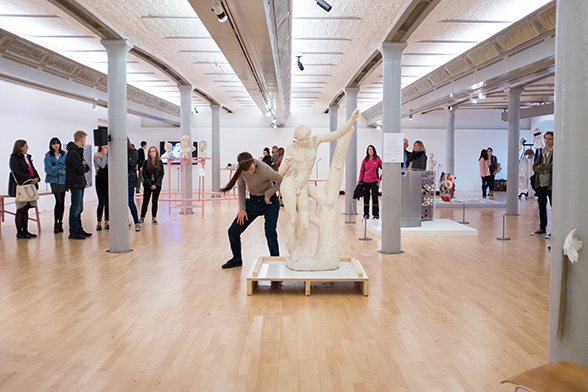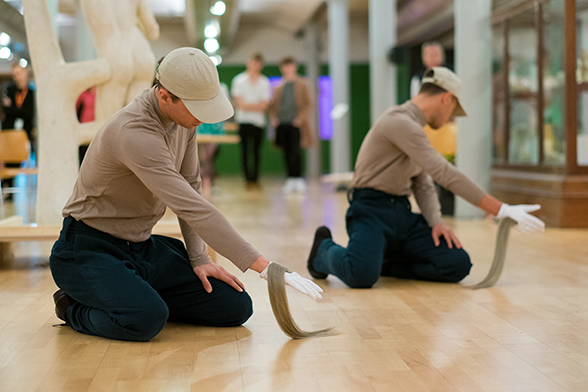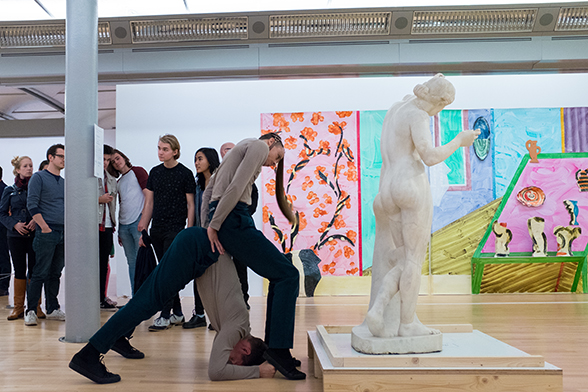Caring for Apollo and Making Presence through Dance: Adam Linder at Tate Liverpool
Posted on 8 October 2016 by Liverpool Biennial

Adam Linder, Choreographic Service No.4 – Some Strands of Support, 7 October 2016. Tate Liverpool. Photo: Mark McNulty
Adam Linder, Choreographic Service No.4 – Some Strands of Support, 7 October 2016. Tate Liverpool. Photo: Mark McNulty
Hair care for statues? Through a three-day performance at Tate Liverpool for Liverpool Biennial 2016 (7-9 October), dancer and choreographer Adam Linder sets out to explore the fetishisation of objects and society’s obsession with their preservation. Gabriella Warren-Smith and Raphaella Davies catch up with the artist.
What should we expect from your performance at Tate Liverpool this weekend?
Some Strands of Support is the fourth performance in a series of ‘choreographed services’. Each work in the series is concerned with the transaction of the performing body and offers a particular service which can be hired per hour or day. The performers propose to transform or serve something in the space. At Tate Liverpool, there will be two performers with hair prostheses, who will move through a series of actions that coerce and care for a statue. The statue, designated by Liverpool Biennial, is of Apollo from the collection at National Museums Liverpool.

Adam Linder, Choreographic Service No.4 – Some Strands of Support, 7 October 2016. Tate Liverpool. Photo: Mark McNulty
Is there any personal link or a particular aspect of hair and its care that draws you to explore it as a subject?
I’m interested in accentuating the fetishistic culture of preservation and accumulation of inanimate objects such as statues. In the performance you have a very bodily, corporeal material that perversely comes into contact with the statue through its care . Within the museological-style display of these objects, touch is forbidden when, as humans, all we want to do is touch these things that we worship. I’m interested in the sensual meaning that evolves when the rigidity of the statue is permeated by the touch of hair. Traditionally hair care is understood to be more feminine, which brings out the contrast between this and the masculine, upright nature of Apollo. It’s almost a passive-aggressive role play.
You’re a trained dancer and choreographer but you’re working within a contemporary art context. How do you find navigating the two ‘worlds’? Do you find there is a certain segregation between them?
I’m still making work within a dance and contemporary theatre context, though I work a lot in the visual arts and have been increasingly invited into that context. They both have different histories and that means there are different things at stake. Visual arts and museological practices have predominantly been about display, archive and history making. Dance, and the field of dance, is about making presence. So for me, it’s interesting to insist on making presence within this context. That’s also why I came to the concept of Services: they are about highlighting the presence and the immediacy of this kind of performative affect. So I like that there is an interesting and productive tension created.

Adam Linder, Choreographic Service No.4 – Some Strands of Support, 7 October 2016. Tate Liverpool. Photo: Mark McNulty
You’ve previously spoken about the idea of living and dead objects in relation to performance and dance in contemporary art. Could you elaborate on this concept?
As a choreographer I’m really not interested in making objects and I think people coming from a visual arts perspective sometimes want to think about performance as an object-like form, whether that’s in the score or documentation. So I’m always trying to move away from this understanding of my works as objects, because they’re not. They are Services.
This idea of offering your service seems more related to choreography and dance, so it’s interesting that you’re introducing it within a contemporary art setting. It’s not something that is often considered, if at all. Can you elaborate?
When I’m talking about the services not many people cotton onto the fact that the performing arts essentially have always been in the service of effective exchanges. You go to the theatre, you buy your ticket, you encounter the experience and then you leave. It’s not about possession or recuperation, it’s very much about economically facilitating that present moment.
What projects and performances will you be working on next? Is this the last in the series?
It’s not the last. I’m in the early stages of working on Service no.5, which will happen next year. I’m going to make a service for five performers. I've been thinking about how, historically, the visual arts have had a scepticism towards theatricality, so these five bodies are going to serve up an antidote to this aversion by theatrically 'parasiting' the neutral white frame.

Adam Linder, Choreographic Service No.4 – Some Strands of Support, 7 October 2016. Tate Liverpool. Photo: Mark McNulty
See Adam Linder’s Some Strands of Support at Tate Liverpool from 7 until 9 October, as part of Liverpool Biennial 2016’s Performance Weekend.
Liverpool Biennial
55 New Bird Street
Liverpool L1 0BW
- T +44 (0)151 709 7444
- info@biennial.com
Liverpool Biennial is funded by
Founding Supporter
James Moores